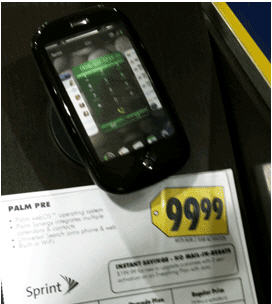
The episode highlights a mobile industry truism: Handset prices are pretty much whatever the seller wants them to be. Subsidies by wireless carriers keep handset prices affordable to consumers, and those subsidies can vary wildly. Buyers seem to have figured that out — it’s completely believable that a Pre would cost less than a BlackBerry Curve 8520.
[aditude-amp id="flyingcarpet" targeting='{"env":"staging","page_type":"article","post_id":117154,"post_type":"story","post_chan":"none","tags":null,"ai":false,"category":"none","all_categories":"business,mobile,","session":"C"}']What’s funny about the Pre pricing episode is the non-response to the ad. The misprinted price didn’t cause stampedes on Best Buy stores the way that, say, “$49 iPhones” might have done. It suggests that smartphone buyers are not choosing their handsets based on price. An employee at another San Francisco Best Buyadmitted to the Journal that the store had only sold two of its three Pres in stock.
VentureBeat's mission is to be a digital town square for technical decision-makers to gain knowledge about transformative enterprise technology and transact. Learn More
